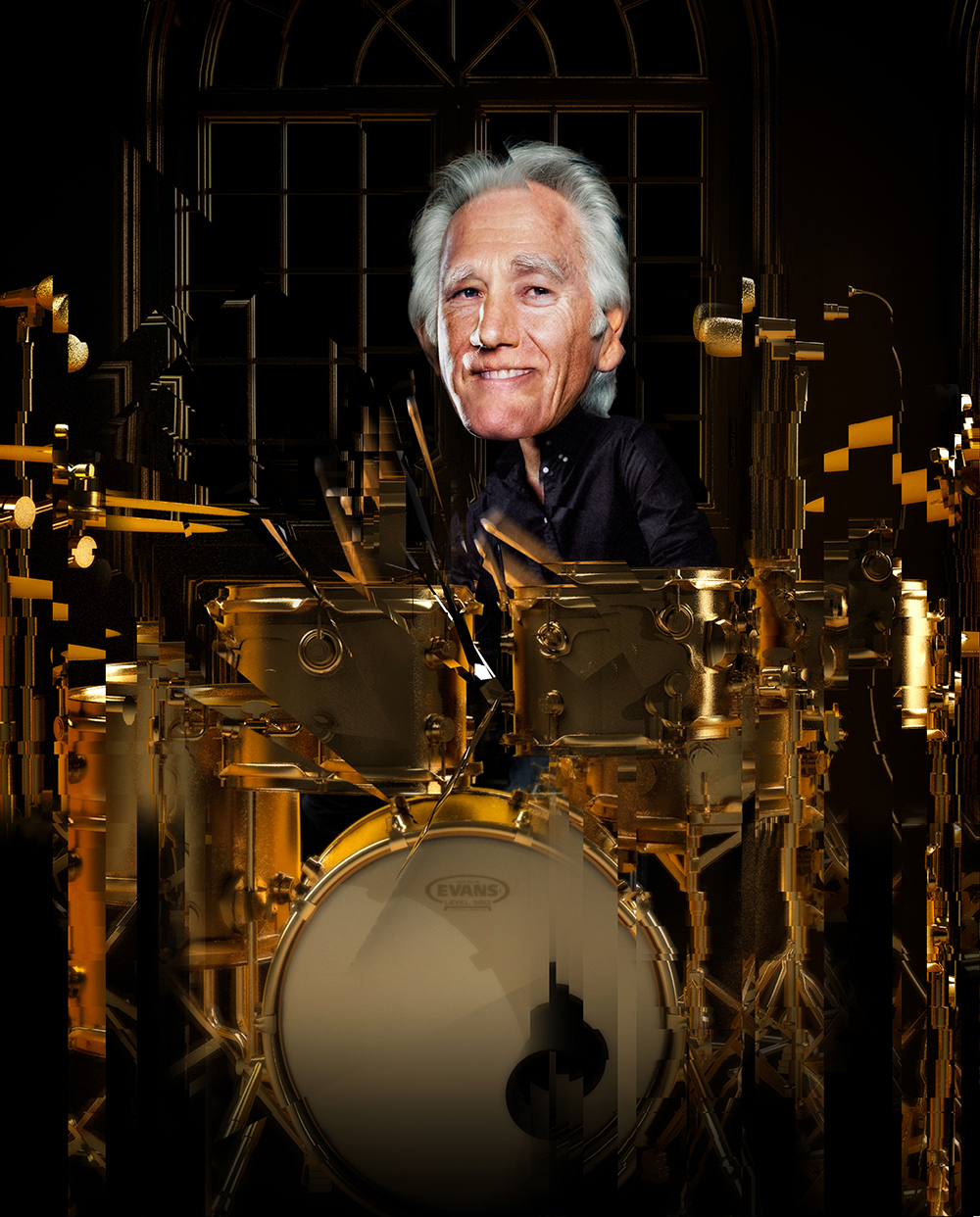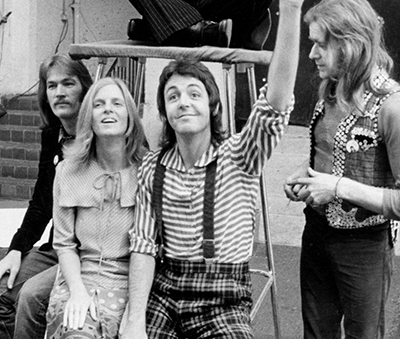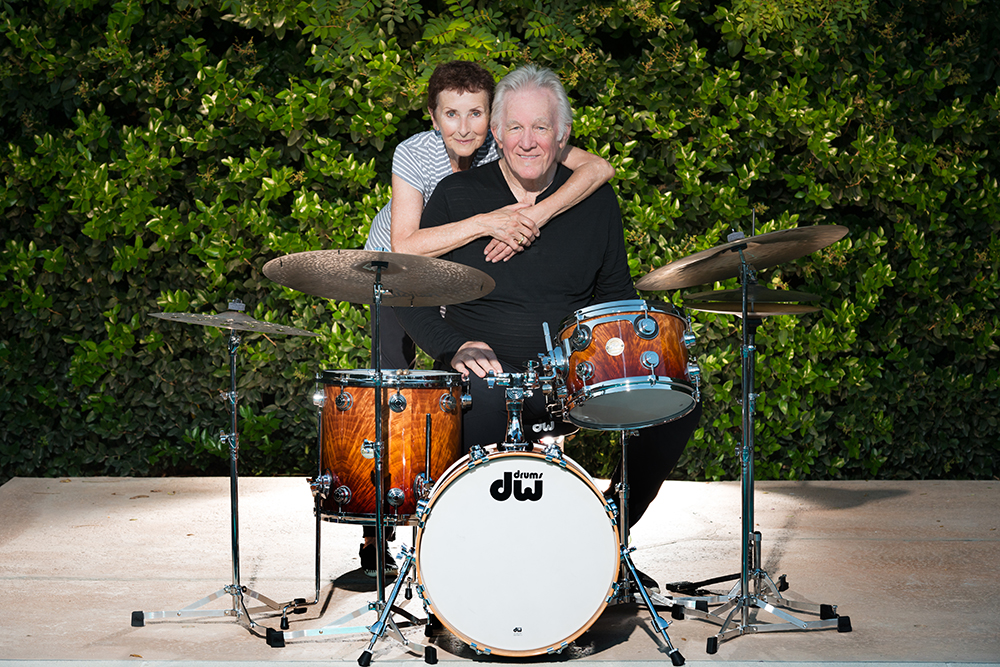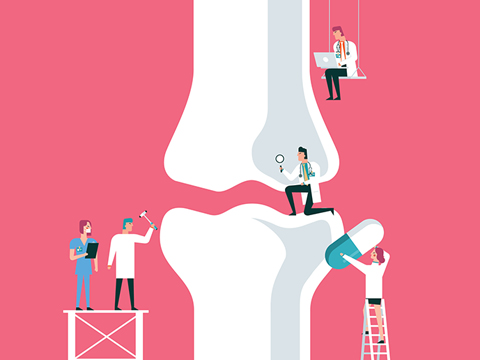Discoveries
The Beat Goes On: How Minimally Invasive Surgery Saved A 77-Year-Old Drummer
Feb 17, 2021 By Sherry Angel, Photo Illustration by Eddie Guy
Just a decade ago, surgical options were limited for people like 77-year-old drummer Denny Seiwell, who came to Cedars-Sinai with a potentially life-threatening aortic aneurysm. But advances in minimally invasive techniques are making major operations safer for patients in their 70s, 80s and even 90s. So what does a new lease on life look like for octogenarians?

Denny Seiwell has a new lease on life after undergoing a highly advanced surgical procedure at Cedars-Sinai. Photo illustration by Eddie Guy.
Denny Seiwell’s life has always been graced by good timing. It’s in his DNA as a second-generation drummer. His dad played with the Dorsey Brothers and started Seiwell on drums when he was just 5 years old. Good timing also served him well at two pivotal points in his life: in 1970, when he auditioned for Paul McCartney in the basement of a dilapidated building in Midtown Manhattan, and in 2019, when he met vascular surgeon Ali Azizzadeh, MD, at Cedars-Sinai.
Seiwell and McCartney hit it off instantly. Seiwell became a founding member of McCartney’s post-Beatles band, Wings (for more on Seiwell’s storied career, see sidebar). The experience was a highlight of a long career performing on the world’s biggest stages with some of the greatest jazz, rock and pop stars. Nearly five decades later, the Pennsylvania native faced a potentially life-threatening health issue that brought him to Azizzadeh’s office.
Seiwell and Azizzadeh hit it off instantly, too. Both the drummer and the doctor discovered their passions early in life and achieved a level of technical skill that is off the charts. Azizzadeh, director of the Division of Vascular Surgery at Cedars-Sinai and a pioneer in developing minimally invasive techniques to treat vascular disease, was able to offer a highly advanced surgical procedure tailored to his patient’s needs. And Seiwell left the doctor’s office with hope that he would be able to quickly get his groove back.
The New Old Age

Patient Denny Seiwell (left) was a founding member of Paul McCartney’s post-Beatles band, Wings.
Seiwell is part of a generation that is redefining what it means to be “old.” Sonja Rosen, MD, chief of Geriatric Medicine at Cedars-Sinai, says medical options for treating serious conditions such as heart disease and cancer now include surgery in cases in which it would have been too dangerous just a decade ago. Minimally invasive techniques that involve smaller incisions, shorter hospital stays, less pain and faster recovery are making it safer for people in their 70s, 80s and even 90s to undergo surgery.
“People are living longer and many of my patients are quite a bit younger than their real age because their functional status is so good,” Rosen says. “There are a lot of reasons for this, including medical advances that help keep people healthy and enable them to age more healthfully, even with chronic medical conditions.”
As the U.S. population ages and minimally invasive medical technology improves, a growing number of older people are becoming candidates for surgery. According to the Centers for Disease Control and Prevention, more than a third of all surgical procedures performed in U.S. hospitals involve patients age
65 and older—and this population is expected to grow dramatically in coming years. The U.S. Census Bureau predicts that by 2034, 77 million Americans will fall into that age bracket—up from more than 54 million in 2019. This will no doubt mean more older people in need of surgery—raising questions about goals, quality of life and when the risks outweigh the potential benefits for each patient. Not all seniors will be candidates for minimally invasive procedures, and surgeons work closely with each patient to ensure their individual needs are met.
Raj Makkar, MD, vice president of Cardiovascular Innovation and Intervention at Cedars-Sinai, has seen patients in their 80s and 90s—even age 100—with advanced aortic stenosis, a narrowing in the heart valve that restricts blood flow, who do remarkably well after aortic valve replacement surgery that uses a catheter threaded through an artery from a very small opening in the groin.
“The symptoms can be debilitating for these patients, but once the valve is replaced, they get back to doing the things they loved before,” says Makkar, the Stephen R. Corday, MD, Chair in Interventional Cardiology. “With the advances in techniques and technologies, we found in our research these minimally invasive approaches have outcomes that are as good or better than traditional open-heart surgery.”
Interventional cardiologists at the Smidt Heart Institute perform more transcatheter procedures than any other hospital in the country. They also lead multiple national clinical trials and investigations using devices that aim to prolong survival and improve patients’ quality of life after surgery.
Rosen also has seen many older patients thrive after minimally invasive knee and hip replacement surgery. Some are able to continue working in their 70s and 80s, while others are simply better able to function safely in their own homes.
“Our goal is to help people age in place successfully—to remain as high functioning and independent as possible with good quality of life for as long as possible, and these types of surgical interventions can make a big difference,” Rosen says.
Raj Makkar, MD, keeps a framed photograph of one of his patients on his desk: a centenarian grinning in front of a vibrant yellow logo at his favorite country radio station. Makkar met him eight years ago when the patient underwent heart valve replacement surgery at age 100.
A ‘Silent Time Bomb’
For Seiwell, having the option of minimally invasive surgery meant being able to keep doing what he loves most. Seiwell’s career began in the New York jazz scene in the mid-’60s after a four-year stint with the U.S. Navy jazz band. Gigs took him to Brazil, where he fell in love with Latin rhythms, and to France, where he met and fell in love with his wife, Monique.
He has recorded more than 200 albums and worked with artists such as Art Garfunkel, James Brown and Billy Joel. He has also played for many TV shows (including Happy Days and Knots Landing) and movie scores (Vertical Limit and Trading Places, among others) and performed with The Who and the London Symphony Orchestra in the rock opera Tommy. Back in the day, Seiwell had shoulder-length brown hair parted in the middle, long sideburns and a mustache. Tall and lean, he looked rock-star cool in jeans, boots and Western-style shirts. He’s aged gracefully into a fuller frame, and his white hair is shorter with a bit of spike. On stage, he has a jazzy vibe in comfortable black attire. At 77, Seiwell could easily settle into a quiet life with his wife of 54 years, but retirement is not on his radar.
"Drumming is my life," Seiwell says.
When he learned he needed surgery for an abdominal aortic aneurysm, he was in the midst of a return to his first love—jazz—and was busy performing in local clubs with several bands. He was particularly enjoying the freedom of recording on his own terms with the Denny Seiwell Trio, which has made two albums that include jazz renditions of a number of classic McCartney songs.
Seiwell’s primary care doctor had been monitoring his slowgrowing aneurysm for a decade. The news that it had reached a size that put him at greater risk of a rupture was unsettling—and not just because he didn’t want anything to slow him down. Two decades earlier, his mother, who had the same condition, had died in surgery after her aneurysm ruptured. She was 74.
An aortic aneurysm is a bulge or swelling in a weakened part of the main artery that transports blood from the heart to the rest of the body. Seiwell was fortunate to receive an early diagnosis. This is unusual, says Azizzadeh, who leads a major surgery referral center at the Smidt Heart Institute for patients with complex aortic aneurysms. He describes these aneurysms as "silent time bombs."
"They tend to be asymptomatic, so people usually don’t know they have it," Azizzadeh explains. "They may be diagnosed through a CT scan for an unrelated problem. If it’s not diagnosed and treated, it can rupture. When that happens, many people die before they get to the hospital."
This condition tends to run in families and is most common in men over 60 who have risk factors such as smoking, high blood pressure and elevated cholesterol. Seiwell acknowledges that his mother’s tragic death made the idea of surgery scary. But when he first met with Azizzadeh, he learned how much this field has advanced in recent years.
"Almost everything we do in vascular surgery has been completely replaced by new technology since I started my career," Azizzadeh says. "The pace of progress is incredible."
He says he has been performing minimally invasive procedures for aortic aneurysms in a growing number of patients in their 70s and older with good results. His expertise, experience and upbeat manner set Seiwell’s mind at ease.
"Dr. Azizzadeh lights up the room when he walks in," Seiwell says. "I needed surgery, and I knew the first time I met him that this was the guy to do it."
The 85-year-old patient wanted to know whether he would be able to return to his favorite pastime—the paddle sport pickleball—after minimally invasive procedure called a laparoscopic total gastrectomy surgery.
Tour De Force Treatment
Azizzadeh is dedicated to offering his older patients the most advanced treatment options to support the best possible quality of life. Azizzadeh says Seiwell would have faced a much more difficult surgery 10 years ago—one that might have been considered too risky, or would have involved weeks or even months of recovery.
“He would have had open surgery with a large incision, a few days on a ventilator in intensive care and two weeks in the hospital,” Azizzadeh explains. “We can now help patients who once had limited treatment options because we are able to fix even complex problems without a large incision.”
Azizzadeh was the first surgeon in the nation to use several different new devices approved by the Food and Drug Administration to repair aortic aneurysms. Azizzadeh performs minimally invasive endovascular aneurysm repair (EVAR) for abdominal aortic aneurysms and a similar procedure called thoracic endovascular aortic repair (TEVAR) for aneurysms in the chest area.
Azizzadeh says Seiwell’s condition was particularly challenging because his aneurysm was located in the part of the aorta that carries blood to the kidneys.
“We had to custom-make a device for him that had branches for the right and left kidney vessels,” Azizzadeh says. “It was a technically advanced repair—a tour de force.”
Seiwell went home with a Band-Aid the day after surgery.

Denny Seiwell is back at his drum kit and embracing life with wife Monique following his surgery. Photo by Alex Solca
Still in Top Form
It wasn’t that Seiwell thought he would lose his edge after a procedure he describes as “a piece of cake from beginning to end.” He just needed to “make sure everything worked.” So the day after surgery, he played the drums.
It gave him an emotional boost—one he has always been able to count on.
Seiwell, who joined a boy’s marching band at age 7 in the small Pennsylvania town where he grew up and started playing professionally as a teenager, never imagined that he’d still be drumming in his 70s.
“When I sit down at the drums, everything I need is there,” he says. “I intend to keep playing as long as I can.”
He’s written a guidebook for drummers that includes sophisticated techniques, such as how to play loudly and softly within the same stroke and make the rhythm float through the tune. He also talks about the importance of knowing “when to stay out of the way.” But Seiwell sees no need for restraint when it comes to expressing gratitude for the care he received from Azizzadeh and his team.
“I can’t say enough good things about them,” he says. Shortly after his surgery, Seiwell posted this message about Azizzadeh on Facebook: “I put my life in this man’s hands, and I’m grateful I did. He’s making a huge difference in the world of medicine and aortic aneurysms.”
He also made a big difference in Seiwell’s world, where the beat goes on.
Severe arthritis in degenerated joints can cause as much pain and disability as a hip or knee fracture, says Cedars-Sinai orthopaedic surgeon Brad Penenberg, MD. A few recent advances in hip and knee replacement surgery are helping older patients undergo surgery with reduced risk and lead more active lives.
A Career Soars With Wings
Denny Seiwell had no idea who he was about to meet or how much his life was about to change.
It was 1970. The Beatles had broken up, and Paul McCartney had come to New York to hold secret auditions for a band to play on his second solo album, Ram.
Seiwell, then at the height of his career as a jazz club drummer and studio musician in Manhattan, was among the first to be invited to audition.
The location in a rundown building made him uneasy, especially when he was directed to the basement. But he’s very glad he didn’t follow an impulse to turn around.
Paul and Linda McCartney were waiting for him alongside a “funky old set of drums.” McCartney asked Seiwell to play some solo rock ’n’ roll. Seiwell had never been in a rock band before, but the versatile drummer knew what to do. He channeled Ringo Starr and let it rip.
McCartney told Billboard magazine in 2001: “Denny Seiwell came along, and he was just great, the best. He had a great attitude, and we got on great; he was a real good all-arounder and he was funky, and we had a laugh.”
Seiwell says: “I met a Beatle and kissed my jazz career goodbye.”
He recorded Ram, then, in 1971, became the first musician McCartney hired to be in his post-Beatles band, Wings.
Seiwell and his wife, Monique, went on tour with the band, traveling to British universities in a van and crossing Europe in an open-top, double-decker bus painted in psychedelic colors. Seiwell played on Wings’ first two albums, Wild Life and Red Rose Speedway. He also recorded the Oscar-nominated James Bond theme, “Live and Let Die,” with Wings and a 40-piece orchestra, before returning to the United States in 1973.
He settled in the Los Angeles area and built a successful drumming career performing in film and TV scores, teaching and, eventually, returning to jazz. But the music and memories he made during his three years with McCartney remain a high point of his life.
“Playing with the best-known man on the planet, being a partner in a new venture with the band—it was a very exciting time,” says Seiwell, who has remained friends with McCartney after all these years.






